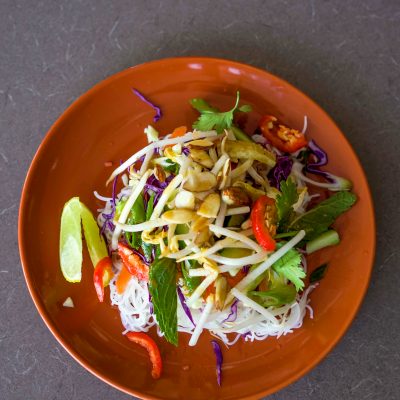Search Results
Produce at its Peak
With the cold, the snow and the somewhat arbitrary marker of the start of a New Year, it’s a good time to try new things, and to make soup. Therefore, I have recently tried to recreate my favorite Thai soup, Tom Yum. It’s fortunate that Seward Co-op has nearly all the exotic ingredients for it right now: organic lemongrass, kaffir limes (an extravagantly fragrant and wrinkled, but juiceless, varietal), and occasionally galangal (if not fresh, you can find in dried in the Grocery department). Tom Yum is essentially a wildly flavorful broth with a few vegetables and shrimp — and it is great when you’re fighting a cold, which many of us are doing right now. I must admit, I don’t make it exactly as they would in Thailand (where I have never been) but this is still a good rendition.
Start by steeping a lemongrass stem, the rind of a quarter of kaffir lime, a small chunk of galangal or ginger, a little fish sauce and some chili paste, all together in a quart of chicken broth. In Thai restaurants, those ingredients will still be floating in the soup when it is served, but I like to strain it before adding brown beech mushrooms, cilantro, scallions, shrimp and thin strips of bell pepper. I also like to squeeze lime juice in at the end and a little turbinado sugar. Serve it hot!
Another tropical item we recently received is tamarind pods, which look like a prehistoric bean. The edible part is the pulp within the brittle pod, which you can break off easily. The pulp is tangy, sticky and clings to the few large, glossy seeds. A lot of people like to chew on tamarind plain, but there are a lot of uses for it, many of them Central American or Asian in origin. My favorite condiment is tamarind chutney, which is simple and fast to prepare. Steep tamarind pulp in a little water and then press it through a sieve to remove any membranes and seeds (the seeds are very pretty and could be used to make beads or gamepieces). Add toasted cumin, cayenne and sugar to taste. Drizzle it over rice, meat, vegetables, or use it as a dipping sauce for samosas or egg rolls.
One of my kitchen staples is garlic, one of the few crops that have not been significantly altered from its wild state by human agricultural selection. Most fruits and vegetables have been selected over millennia to be more tender, less bitter and sweeter than the wild originals. This results in them being more pleasing to the human palate, but generally no where near as nutritious. Garlic is widely known to be a medicinal food, good for preventing cancer and fighting bacteria, but there’s a trick to that. If you chop up garlic and then cook it right away, those properties are drastically reduced. However, by chopping and allowing it to sit for ten minutes before cooking it, you can preserve garlic’s nutritional bounty. Of course you can always eat it raw, too, and garner all the benefits — if you don’t mind the bite that raw garlic has.
— Hannah B., Assistant Produce Manager
